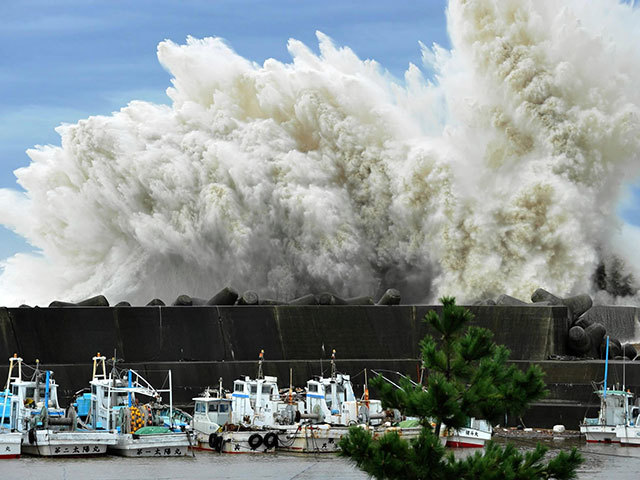
Typhoon Neoguri headed toward Japan’s southernmost main island of Kyushu, prompting the evacuation of almost 90,000 people amid the threat of floods and landslides.
Neoguri was west of Kyushu with top winds reaching 162 kilometers (101 miles) per hour, down from yesterday’s 252 kph, according to the Japan Meteorological Agency. The storm, which was heading northeast as of 3.55pm local time, left 20 injured in Okinawa yesterday, where it grounded flights and prompted evacuations.
Parts of Kyushu will probably be hit by tomorrow with violent winds, swollen rivers and waves up to 10 meters high, the weather agency reported on its website.
Officials in the Kyushu city of Amakusa urged 87,327 residents today to take shelter in gyms and other buildings being used as evacuation centers, as the storm threatened homes, public broadcaster NHK reported on its website.
Companies with Kyushu factories, including Nissan Motor Co. and Toshiba Corp., were watching the storm’s approach.
Nansei Sekiyu KK, a unit of Brazil’s Petroleo Brasileiro SA, halted refining and shipping operations yesterday at its 100,000 barrel-a-day Nishihara plant in Okinawa, the company said in an e-mailed statement.
Marine operations at JX Nippon Oil & Energy Corp.’s 270,000-barrel-a-day Negishi refinery near Tokyo remained suspended today because of high waves caused by the storm’s approach, according to a company official who asked not to be identified because of internal policy.
“We instructed factories and offices in Japan to take measures for safety against the approaching typhoon,” said Yu Takase, a spokeswoman for Toshiba, which has a chip factory in Kyushu’s Oita prefecture. “Right now, our factories are operating as usual.”
Nissan and Toyota Motor Corp. were monitoring the storm and planned to decide on any countermeasures to be taken tomorrow by this evening, the companies said.
Toyota and Nissan built 1.32 million vehicles at their four plants in Kyushu last year, Satomi Hamada, a production analyst for IHS Automotive, wrote in an e-mail.
Nissan’s two plants on the island accounted for 65 percent of the company’s domestic production last year, while Toyota’s portion was 18%.
The storm’s was expected to pivot east as Neoguri interacts with a low-pressure system over Manchuria, said Jim Andrews, a meteorologist with AccuWeather Inc. in State College, Pennsylvania. The low has created a vigorous westerly jet stream that will push the storm into Kyushu.
“The storm is clearly weakening,” he said. “We’re thinking more a minimal typhoon or a strong tropical storm as it crosses the southwest coast of Kyushu.”
Japan Airlines Co. and its affiliates grounded 11 flights to and from southern Japan today as of 4pm, the company said in an e-mailed statement. The All Nippon Airways Co. group canceled 29 flights, affecting 2,000 passengers.
One serious injury in Okinawa was attributed to the storm, while 19 other people suffered slight injuries, according to a statement from Japan’s Fire and Disaster Management Agency, which gave no other details.
The Mainichi newspaper reported that a man died yesterday after the fishing boat he was aboard capsised off the island of Shikoku farther northeast from the storm’s center, where the weather agency has a high-wave advisory in effect.
In the Okinawan city of Miyako, residents who had been urged to take shelter from the storm in community centers and municipal buildings returned to their homes after an evacuation alert was lifted yesterday at 6.30pm, disaster prevention spokesman Satoshi Shimoji said.
Customers of NTT Docomo Inc., Japan’s largest wireless carrier, continued to experience service blackouts in some remote parts of Okinawa, according to a map on the company’s website.
Neoguri, which means raccoon in Korean, had sustained winds of 108 kilometers per hour. The Japanese Meteorological Agency has dropped emergency warnings for the area while maintaining alerts for high winds, thunderstorms, heavy rain, strong winds and possible landslides in parts of Kyushu.
“Heavy rains causing major flooding will be the main concern, due to saturated soils on Kyushu caused by very heavy rains since Thursday from a stalled front,” said Jeff Masters, co-founder of Weather Underground in Ann Arbor, Michigan.
Japan has averaged more than 11 typhoons per year over a 30-year period ending in 2010, most of them occurring between July and October, according to the weather agency’s website.
“The strength of the typhoon is a once-in-several-decades event,” Akihiro Ohta, Japan’s transport minister, told reporters in Tokyo yesterday. “We urge people to pay attention to warnings from their local governments.”
Andrews said the remnants of Neoguri may hug Japan’s east coast. He said Tokyo itself will probably be spared the worst because it is sheltered by mountains to the south.